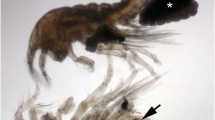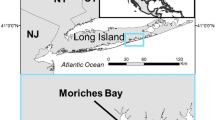Abstract
We studied the distribution of the “bitter-crab” syndrome, a disease caused by the parasitic dinoflagellate Hematodinium sp., in eight commercial species of crabs in the west of the Bering and Chukchi seas. The crabs (25 388 individuals) were sampled during bottom trawl surveys of July‒September 2010 and October‒November 2012. The disease was first identified visually by a color change of the exoskeleton and the hemolymph of the animals and then using microscope analysis of hemolymph samples. Infestation was detected in crabs of three species, Chionoecetes opilio, C. bairdi, and Paralithodes platypus. The prevalence of the disease (the percent of infected individuals relative to all of those examined) in C. bairdi and P. platypus was very low, 0.1 and 0.3%, respectively. Infestation was widespread among C. opilio, its peak in the Bering Sea was in the fall. The average prevalence of the crab disease in different areas of the Bering Sea ranged from 0.8 to 10.8%. A high rate of crab infection was recorded in the Korfa Bay. In the Chukchi Sea, the average prevalence was 2%. Infestation by Hematodinium sp. was not revealed in the deep-sea snow crabs Chionoecetes tanneri and C. angulatus, and in three species of lithodid crabs, Paralithodes camtschaticus, P. brevipes, and Lithodes couesi. This can be explained by the small sample volume and/or ecology of these species, since the disease was registered in other areas in four of them.
Similar content being viewed by others
References
Dudnikov, S.A., Kolichestvennaya epizootologiya: osnovy prikladnoi epidemiologii i biostatistiki (Quantitative Epizootiology: Basics of Applied Epidemiology and Biostatistics), Vladimir: Demiurg, 2004.
Karmanova, I.V. and Ryazanova, T.V., Parasitic dinoflagellates of the genus Hematodinium in commercial crabs of West Kamchatka shelf, Mater. mezhd. nauch. konf. “Bioraznoobrazie i ekologiya parazitov nazemnykh i vodnyhh tsenozov” (Moskva, 9–11 dekabrya 2008 g.) (Proc. Int. Sci. Conf. “Biodiversity and Ecology of Parasites of Terrestrial and Water Cenoses,” Moscow, December 9–11, 2008), Moscow: Inst. Probl. Ekol. Evol., Ross. Akad. Nauk, 2008, pp. 164–167.
Metelev, E.A. and Ryazanova, T.V., Some parasites of the golden king crab Lithodes aequispinus in the northern part of the Sea of Okhotsk, Materialy dokladov otchetnoi sessii MagadanNIRO po rezul’tatam nauchnykh issledovanii za 2012 g. (Magadan, 6 fevralya 2013 g.) (Material Repts Reporting Session the Magadan Scientific Research Institute of Fisheries and Oceanography on the Results of Scientific Researches of 2012 (Magadan, February 6, 2013), Magadan: Novaya Poligrafiya, 2013, pp. 97–100.
Slizkin, A.G. and Safronov, S.G., Promyslovye kraby prikamchatskikh vod (Commercial Crabs of the Kamchatka Waters) Petropavlovsk-Kamchatskii: Severnaya Patsifika, 2000.
Bower, S.M., Meyer, G.R., Phillips A., et al., New host and range extension of bitter-crab syndrome in Chionoecetes spp. caused by Hematodinium sp., Bull. Eur. Assoc. Fish Pathol., 2003, vol. 23, no. 2, pp. 86–91.
Coats, D.W., Parasitic life styles of marine dinoflagellates, J. Eukaryotic Microbiol., 1999, vol. 46, no. 4, pp. 402–409.
Dawe, E.G., Trends in the prevalence of bitter-crab disease caused by Hematodinium sp. in snow crab (Chionoecetes opilio) throughout the Newfoundland and Labrador continental shelf, Crabs in Cold Water Regions: Biology, Management, and Economics. Alaska Sea Grant Report AK-AG-02-01. Alaska Sea Grant Program, Fairbanks, AK: Univ. of Alaska, 2002, pp. 385–400.
Jensen, P.C., Califf, K., Lowe, V., et al. Molecular detection of Hematodinium sp. In Northeast Pacific Chionoecetes spp. and evidence of two species in the Northern Hemisphere, Dis. Aquat. Org., 2010, vol. 89, no. 2, pp. 155–166.
Meyers, T.R., Infection with Hematodinium, AFS Fish Health Section BLUE BOOK. Suggested Procedures for theDdetection and Iidentification of Certain Finfish and Shellfish Pathogens, 2014. http://www.afs-fhs.org/perch/resources/hematodinium-infection-of-crustaceans-2014.pdf.
Meyers, T.R., Koeneman, T.M., Botelho, C., et al., Bitter crab disease: a fatal dinoflagellate infection and marketing problem for Alaskan Tanner crabs Chionoecetes bairdi, Dis. Aquat. Org., 1987, vol. 3, no. 3, pp. 195–216.
Meyers, T.R., Morado, J.F., Sparks, A.K., et al., Distribution of bitter-crab syndrome in Tanner crabs (Chionoecetes bairdi,C. opilio) from the Gulf of Alaska and the Bering Sea, Dis. Aquat. Org., 1996, vol. 26, no. 3, pp. 221–227.
Morado, J.F., Protistan diseases of commercially important crabs: a review, J. Invertebrate Pathol., 2011, vol. 106, pp. 27–53.
Morado, J.F., Dawe, E.G., Mullowney, D., et al., Climate change and the worldwide emergence of Hematodinium-associated disease: is there evidence for a relationship? Biology and Management of Exploited Crab Populations under Climate Cange. Alaska Sea Grant College Program, Fairbanks, AK: Univ. of Alaska, 2010, pp. 153–173.
Pestal, G.P., Taylor, D.M., Hoenig, J.M., et al., Monitoring the prevalence of the parasitic dinoflagellate Hematodinium sp. in snow crabs Chionoecetes opilio from Conception Bay, Newfoundland, Dis. Aquat. Org., 2003, vol. 53, no. 1, pp. 67–75.
Ryazanova, T.V., Eliseikina, M.G., Kukhlevsky, A.D., and Kharlamenko, V.I., Hematodinium sp. infection of red king crab Paralithodes camtschaticus and blue king crab Paralithodes platypus from the north-eastern part of the Okhotsk Sea, Russia, J. Invertebrate Pathol., 2010, vol. 105, no. 3, pp. 329–334.
Shields, J.D., The parasitic dinoflagellates of marine crustaceans, Annu. Rev. Fish Dis., 1994, vol. 4, pp. 241–271.
Small, H.J., Advances in our understanding of the global diversity and distribution of Hematodinium spp.–significant pathogens of commercially exploited crustaceans, J. Invertebrate Pathol., 2012, vol. 110, pp. 234–246.
Stentiford, G.D., Neil, D.M., and Atkinson. R.J.A., The relationship of Hematodinium infection prevalence in a Scottish Nephrops norvegicus population to season, moulting and sex, ICES J. Mar. Sci., 2001, vol. 58, no. 4, pp. 814–823.
Stentiford, G.D., Neil, D.M., Peeler, E.J., et al., Disease will limit future food supply from the global crustacean fishery and aquaculture sectors, J. Invertebrate Pathol., 2012, vol. 110, pp. 141–157.
Stentiford, G.D. and Shields, J.D., A review of the parasitic dinoflagellates Hematodinium species and Hematodinium-like infections in marine crustaceans, Dis. Aquat. Org., 2005, vol. 66, no. 1, pp. 47–70.
Author information
Authors and Affiliations
Corresponding author
Additional information
Original Russian Text © T.V. Ryazanova, P.A. Fedotov, V.I. Kharlamenko, 2016, published in Biologiya Morya.
Rights and permissions
About this article
Cite this article
Ryazanova, T.V., Fedotov, P.A. & Kharlamenko, V.I. The bitter crab syndrome in commercial crabs in the Western part of the Bering and Chukchi Seas. Russ J Mar Biol 42, 409–413 (2016). https://doi.org/10.1134/S1063074016050096
Received:
Published:
Issue Date:
DOI: https://doi.org/10.1134/S1063074016050096




